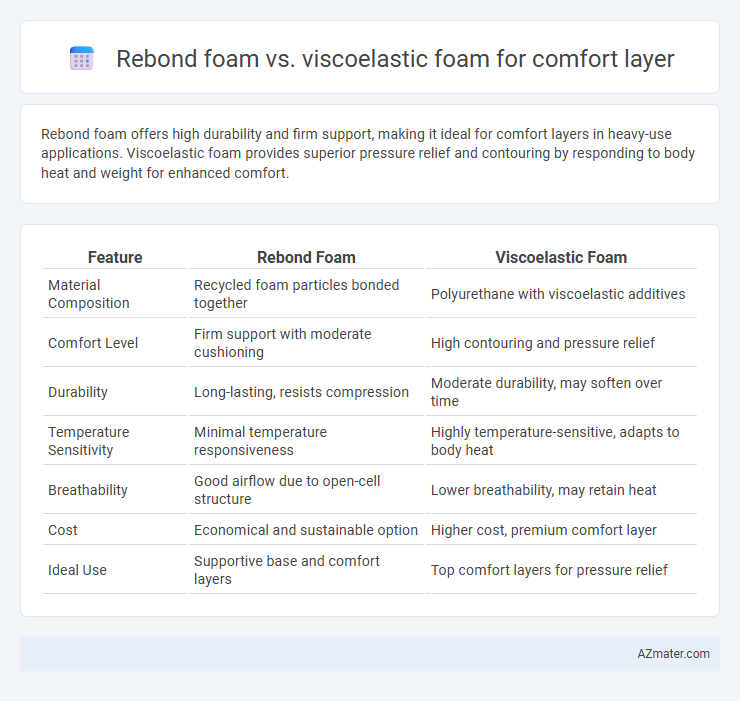Rebond foam offers high durability and firm support, making it ideal for comfort layers in heavy-use applications. Viscoelastic foam provides superior pressure relief and contouring by responding to body heat and weight for enhanced comfort.
Table of Comparison
| Feature | Rebond Foam | Viscoelastic Foam |
|---|---|---|
| Material Composition | Recycled foam particles bonded together | Polyurethane with viscoelastic additives |
| Comfort Level | Firm support with moderate cushioning | High contouring and pressure relief |
| Durability | Long-lasting, resists compression | Moderate durability, may soften over time |
| Temperature Sensitivity | Minimal temperature responsiveness | Highly temperature-sensitive, adapts to body heat |
| Breathability | Good airflow due to open-cell structure | Lower breathability, may retain heat |
| Cost | Economical and sustainable option | Higher cost, premium comfort layer |
| Ideal Use | Supportive base and comfort layers | Top comfort layers for pressure relief |
Introduction to Comfort Layer Materials
Rebond foam, crafted from shredded and re-bonded polyurethane foam pieces, offers high density and durability, making it a cost-effective comfort layer with firm support and pressure relief. Viscoelastic foam, commonly known as memory foam, responds to body heat and pressure, providing superior contouring and motion isolation for enhanced comfort. Selecting between rebond and viscoelastic foam depends on the desired balance between firmness, durability, and adaptive cushioning in mattress or seating applications.
What is Rebond Foam?
Rebond foam is a durable and supportive material made by shredding and fusing foam scraps, commonly used as a comfort layer in mattresses and cushions for enhanced resilience and breathability. Compared to viscoelastic foam, which conforms closely to body shape and provides pressure relief through memory foam characteristics, rebond foam offers firmer support and better airflow, making it ideal for users who prefer a balance of comfort and structural firmness. Its recycled nature also contributes to sustainability, positioning rebond foam as an eco-friendly alternative in comfort layer applications.
What is Viscoelastic Foam?
Viscoelastic foam, commonly known as memory foam, is a temperature-sensitive material that molds to the body's contours, providing personalized support and pressure relief. Unlike rebond foam, which is made from shredded foam pieces bonded together for durability and firmness, viscoelastic foam offers superior comfort by responding to heat and weight, enhancing spinal alignment. Its high-density composition ensures minimal motion transfer and lasting resilience, making it a preferred choice for comfort layers in mattresses and cushions.
Key Physical Properties Compared
Rebond foam offers high density and firm support with excellent durability, making it ideal for heavy-duty comfort layers requiring resilience and pressure distribution. Viscoelastic foam, commonly known as memory foam, features lower density with open-cell structure, providing superior contouring, slow recovery, and enhanced motion isolation. Key physical properties such as ILD (Indentation Load Deflection) illustrate rebond foam's higher firmness compared to viscoelastic foam's softer, temperature-sensitive response that molds to body shape for personalized comfort.
Comfort and Pressure Relief Analysis
Rebond foam, made from recycled foam scraps, offers firm support with moderate cushioning, making it suitable for durable comfort layers that evenly distribute body weight but provide less contouring compared to viscoelastic foam. Viscoelastic foam, also known as memory foam, excels in pressure relief by contouring closely to body shape, reducing pressure points and enhancing comfort through superior weight distribution and motion isolation. In comfort layer applications, viscoelastic foam outperforms rebond foam in alleviating joint stress and improving sleep quality due to its viscoelastic properties that respond dynamically to body heat and pressure.
Durability and Lifespan Differences
Rebond foam offers high durability due to its dense composition made from shredded foam pieces fused together, resulting in a resilient comfort layer with a longer lifespan in high-traffic applications. Viscoelastic foam, also known as memory foam, provides excellent pressure relief and contouring but tends to degrade faster over time, especially under constant weight, reducing its longevity compared to rebond foam. The lifespan of rebond foam typically exceeds 10 years in mattresses and cushions, whereas viscoelastic foam durability ranges between 6 to 8 years depending on density and usage.
Temperature Sensitivity and Breathability
Rebond foam offers higher breathability due to its open-cell structure, promoting better air circulation and cooler sleep environments, while viscoelastic foam, known for temperature sensitivity, softens with body heat to provide contouring support but tends to retain more heat. The temperature-reactive nature of viscoelastic foam can sometimes lead to discomfort in warmer climates, whereas rebond foam maintains more consistent firmness and temperature neutrality. Mattress designs often combine both materials to balance pressure relief, temperature regulation, and airflow for optimal comfort.
Motion Isolation Capabilities
Rebond foam offers moderate motion isolation by absorbing impact and reducing transfer, but it tends to be less effective compared to viscoelastic foam. Viscoelastic foam, also known as memory foam, excels in motion isolation due to its ability to conform to body contours and absorb movement energy, minimizing disturbance across the mattress surface. This superior motion isolation makes viscoelastic foam a preferred choice for couples or light sleepers seeking enhanced comfort and undisturbed rest.
Price and Value Assessment
Rebond foam offers a cost-effective comfort layer option with high durability and good support, making it ideal for budget-conscious consumers seeking long-lasting performance. Viscoelastic foam, also known as memory foam, typically comes at a higher price point but delivers superior contouring and pressure relief, enhancing overall sleep quality and comfort. When assessing value, rebond foam is preferred for affordability and resilience, while viscoelastic foam is favored for advanced comfort and therapeutic benefits despite its premium cost.
Which Foam is Best for Your Needs?
Rebond foam offers high durability and firm support, making it ideal for heavy-use furniture or areas requiring resilient cushioning. Viscoelastic foam, commonly known as memory foam, contours to the body, providing superior pressure relief and personalized comfort for mattresses and pillows. Choosing the best foam depends on your preference for either firm, long-lasting support with rebond foam or adaptive softness and pressure mitigation with viscoelastic foam.

Infographic: Rebond foam vs Viscoelastic foam for Comfort layer
 azmater.com
azmater.com